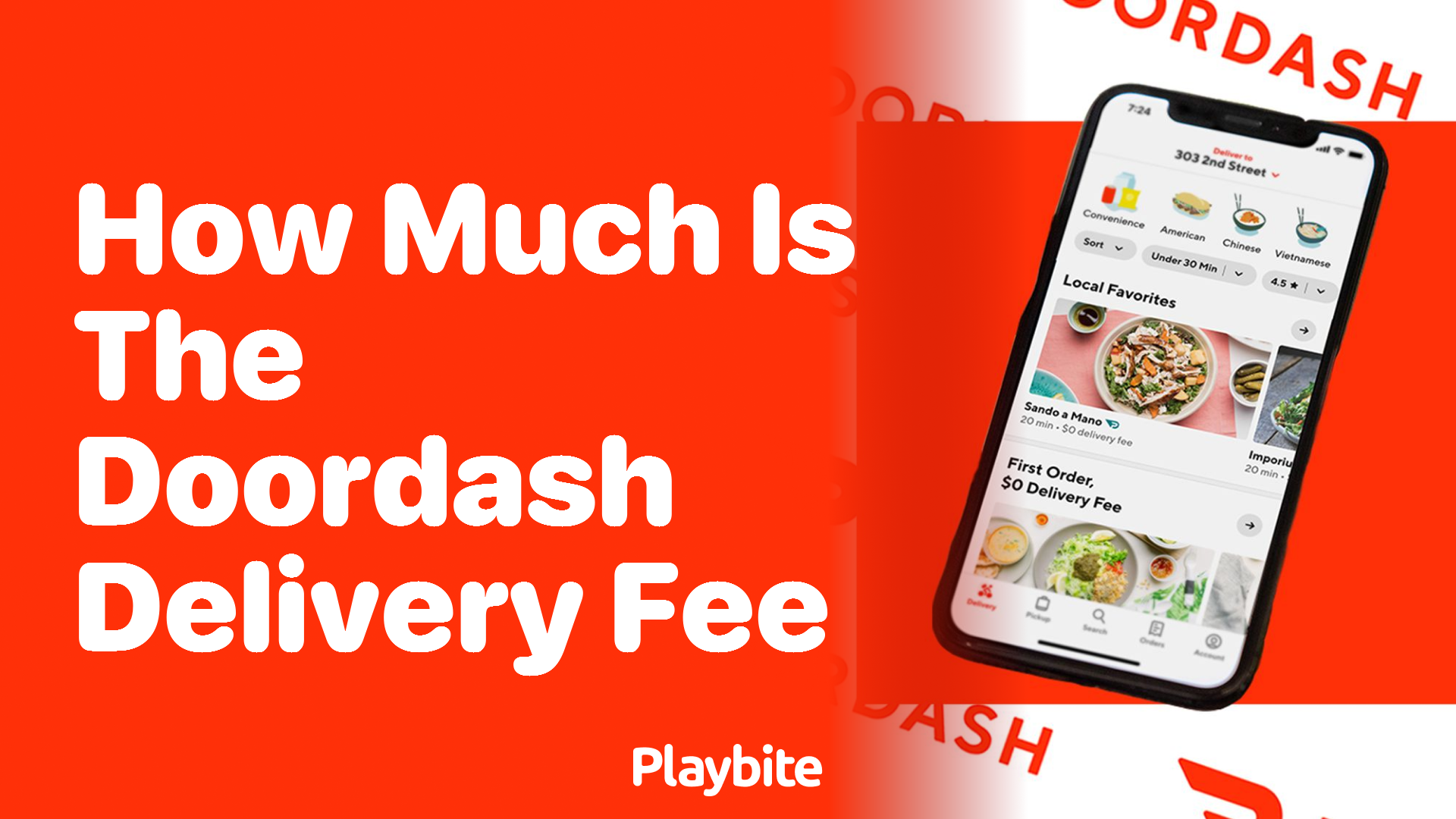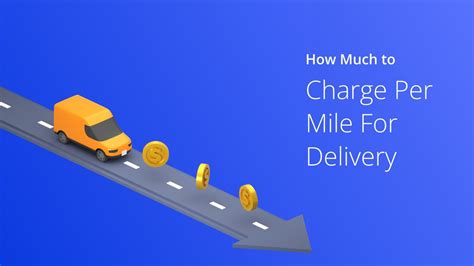How Much Is Delivery Fee

In today's fast-paced world, delivery services have become an integral part of our lives, offering convenience and efficiency. From food deliveries to e-commerce packages, understanding the associated delivery fees is essential for both consumers and businesses alike. In this comprehensive article, we will delve into the world of delivery fees, exploring the various factors that influence them, the methods used to calculate them, and the strategies employed by businesses to optimize their delivery processes.
The Evolution of Delivery Fees

Delivery fees have undergone a significant transformation over the years, shaped by advancements in technology, changing consumer expectations, and the dynamic nature of the logistics industry. In the early days of e-commerce, delivery fees were often standardized, with a flat rate applied to all orders regardless of their size or destination. However, as the industry matured, businesses began to recognize the need for more nuanced and flexible fee structures.
The introduction of dynamic pricing models revolutionized the way delivery fees are determined. Instead of a one-size-fits-all approach, businesses now leverage data-driven algorithms to calculate fees based on various factors such as distance, package weight, delivery time, and even weather conditions. This shift towards dynamic pricing not only ensures fairness but also allows businesses to optimize their operations and offer more competitive rates to customers.
Factors Influencing Delivery Fees

The cost of delivering goods or services is influenced by a multitude of factors, each playing a crucial role in determining the final fee. Understanding these factors is essential for businesses to set accurate and competitive prices, while also providing transparency to their customers.
Distance and Geography
One of the primary factors impacting delivery fees is the distance between the sender and the recipient. The longer the distance, the higher the fuel costs, driver expenses, and potential time spent on the road. Additionally, geographical factors such as remote locations, rural areas, or challenging terrain can significantly increase the complexity and cost of delivery.
| Distance Category | Estimated Delivery Fee |
|---|---|
| Urban (Up to 10 km) | $5 - $10 |
| Suburban (10 - 50 km) | $10 - $20 |
| Regional (50 - 200 km) | $20 - $40 |
| Long-Haul (Over 200 km) | $40+ (Varies) |

Package Size and Weight
The size and weight of the package being delivered are critical factors in determining the delivery fee. Larger and heavier packages require more fuel, larger vehicles, and potentially specialized handling equipment. As a result, delivery fees often increase exponentially with the size and weight of the shipment.
Time Constraints and Rush Deliveries
Delivery fees can also be influenced by time constraints and the urgency of the delivery. Rush deliveries, which require expedited handling and transportation, often come with a premium. Businesses may offer different pricing tiers based on the desired delivery time, with same-day or overnight deliveries commanding higher fees.
Additional Services and Special Requirements
Certain deliveries may require additional services or special handling, which can impact the overall fee. For example, deliveries to hard-to-reach locations, such as apartments with limited access or construction sites, may incur surcharges. Additionally, services like white-glove delivery, where the delivery team assists with installation or setup, can add significant value but also increase the cost.
Calculating Delivery Fees: Methods and Strategies
The calculation of delivery fees is a complex process that involves various methodologies and strategies. Businesses employ a range of techniques to ensure fair pricing, optimize their operations, and provide a seamless experience for customers.
Traditional Flat-Rate Fees
Despite the shift towards dynamic pricing, some businesses still opt for traditional flat-rate delivery fees. This approach simplifies the pricing structure, making it easier for customers to understand and compare. Flat-rate fees are often based on average delivery costs and are applied consistently across all orders, regardless of their specific characteristics.
Zone-Based Pricing
Zone-based pricing is a popular method used by many delivery services, particularly for regional or national deliveries. Businesses divide their delivery areas into zones, with each zone having a corresponding fee. The fees are typically determined based on factors like distance, population density, and transport infrastructure. Zone-based pricing provides a balanced approach, offering fairness and simplicity while accounting for varying costs across different regions.
Real-Time Dynamic Pricing
Real-time dynamic pricing is a cutting-edge approach that leverages advanced algorithms and data analytics to calculate delivery fees on the fly. This method takes into account a multitude of factors, including real-time traffic conditions, weather updates, and package attributes. By continuously optimizing fees, businesses can offer competitive rates and ensure efficient route planning, ultimately enhancing the overall delivery experience.
Variable Pricing Models
Some businesses employ variable pricing models, where delivery fees are determined by a combination of factors. These models often consider elements such as order value, customer loyalty, and delivery frequency. For instance, businesses may offer discounted or waived delivery fees for high-value orders or frequent customers, incentivizing repeat business and fostering customer loyalty.
Optimizing Delivery Processes for Cost-Effectiveness
In today’s competitive landscape, businesses strive to optimize their delivery processes to reduce costs and enhance efficiency. By implementing strategic initiatives and leveraging technology, they can improve their bottom line while delivering an exceptional customer experience.
Route Optimization and Fleet Management
Efficient route planning and fleet management are critical aspects of optimizing delivery processes. By utilizing advanced routing algorithms and GPS tracking, businesses can minimize travel distances, reduce fuel consumption, and optimize delivery times. Additionally, effective fleet management involves maintaining vehicles in top condition, ensuring timely maintenance, and considering alternative fuel options to reduce environmental impact and operational costs.
Last-Mile Delivery Innovations
The last mile of delivery, where packages are transported from a distribution center to the final destination, is often the most challenging and costly segment. To address this, businesses are exploring innovative solutions such as crowdsourced delivery networks, where independent contractors or gig workers handle the last mile. This approach can significantly reduce costs and improve delivery flexibility, especially in urban areas with high population density.
Collaboration and Partnerships
Collaborating with other businesses or delivery service providers can be a cost-effective strategy. By sharing resources, vehicles, and infrastructure, businesses can reduce overhead costs and improve operational efficiency. Partnerships can also lead to shared distribution centers or consolidated deliveries, further streamlining the delivery process and reducing costs.
The Impact of Technology on Delivery Fees

Technology has played a pivotal role in shaping the logistics industry and, by extension, delivery fees. From advanced analytics to real-time tracking, technological advancements have transformed the way businesses operate and customers experience deliveries.
Real-Time Tracking and Transparency
Real-time tracking has become a standard feature in the delivery landscape, providing customers with unprecedented visibility into the status of their orders. This transparency not only enhances the customer experience but also helps businesses manage expectations and reduce customer inquiries. Additionally, real-time tracking enables businesses to identify and address potential delays or issues promptly, optimizing the delivery process and reducing associated costs.
Automated Order Fulfillment and Dispatch
Automated order fulfillment systems and dispatch software have revolutionized the way deliveries are managed. These technologies streamline the entire process, from order intake to dispatch, reducing human error and increasing efficiency. By automating tasks like order processing, route optimization, and delivery tracking, businesses can reduce operational costs and improve overall delivery performance.
Data Analytics and Predictive Modeling
Data analytics and predictive modeling are powerful tools that businesses leverage to optimize their delivery processes and fees. By analyzing historical data, businesses can identify trends, predict demand, and optimize pricing strategies. This enables them to make data-driven decisions, adjust delivery fees based on market conditions, and ensure a competitive edge.
The Future of Delivery Fees: Trends and Predictions
As the logistics industry continues to evolve, delivery fees will remain a dynamic and ever-changing aspect of the business landscape. Several trends and predictions shape the future of delivery fees, offering insights into how businesses and consumers can expect to navigate this evolving landscape.
Rise of Subscription-Based Delivery Models
Subscription-based delivery models are gaining traction, particularly in the e-commerce and food delivery sectors. These models offer customers the convenience of regular deliveries at a fixed monthly or annual fee. While this approach may reduce the need for per-delivery fees, businesses must carefully consider the cost of maintaining a subscription base and ensuring consistent customer satisfaction.
Increased Focus on Sustainability
Sustainability is becoming an increasingly important consideration for both businesses and consumers. As such, delivery fees may begin to reflect the environmental impact of transportation. Businesses may explore carbon-neutral delivery options or implement eco-friendly practices, such as electric vehicle fleets or optimized routing to reduce emissions. These initiatives not only enhance sustainability but also differentiate businesses in a competitive market.
Integration of AI and Machine Learning
Artificial Intelligence (AI) and Machine Learning (ML) are poised to play a significant role in shaping the future of delivery fees. These technologies can optimize route planning, predict delivery demand, and automate pricing adjustments based on real-time data. By leveraging AI and ML, businesses can achieve unprecedented levels of efficiency and cost-effectiveness, ultimately enhancing the overall delivery experience.
How do businesses determine delivery fees for international shipments?
+International delivery fees are influenced by factors such as distance, customs procedures, and local regulations. Businesses often use zone-based pricing or flat rates for specific countries, taking into account the complexities of cross-border shipments.
Are there any ways to negotiate delivery fees with businesses?
+While delivery fees are often non-negotiable, businesses may offer discounts or promotions to attract new customers or encourage repeat purchases. Additionally, bulk orders or high-value purchases may qualify for reduced fees or free delivery.
What are some best practices for businesses to optimize delivery costs without compromising quality?
+Businesses can optimize delivery costs by investing in efficient route planning, utilizing technology for real-time tracking and dispatch, and exploring collaborative partnerships. Additionally, offering flexible delivery options, such as pick-up points or extended delivery windows, can reduce costs while maintaining customer satisfaction.


